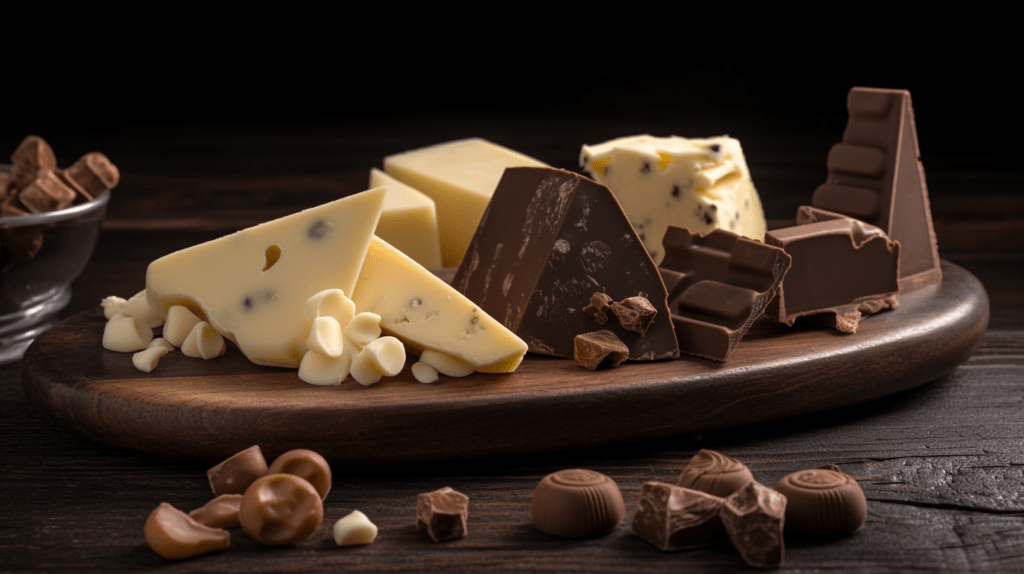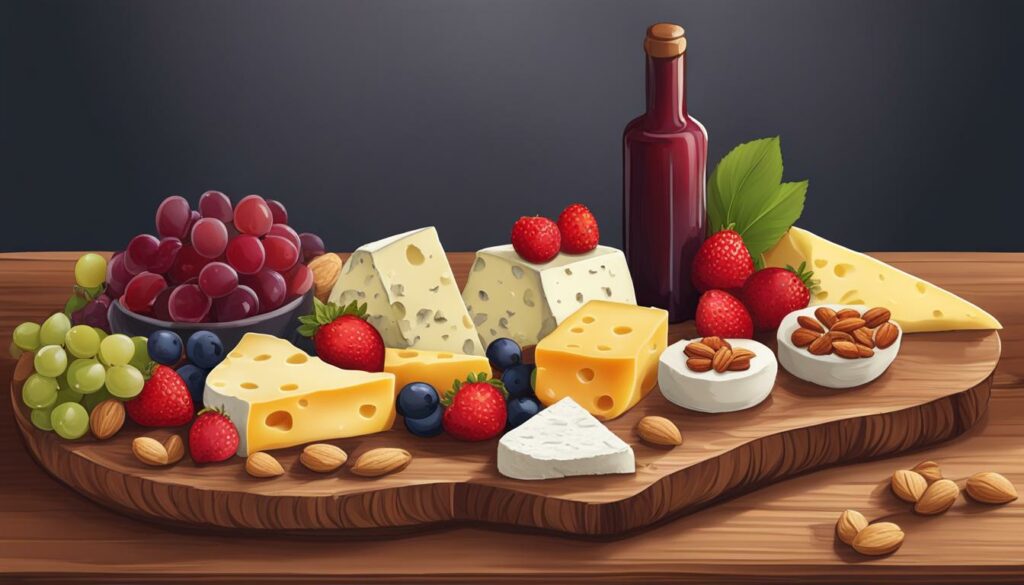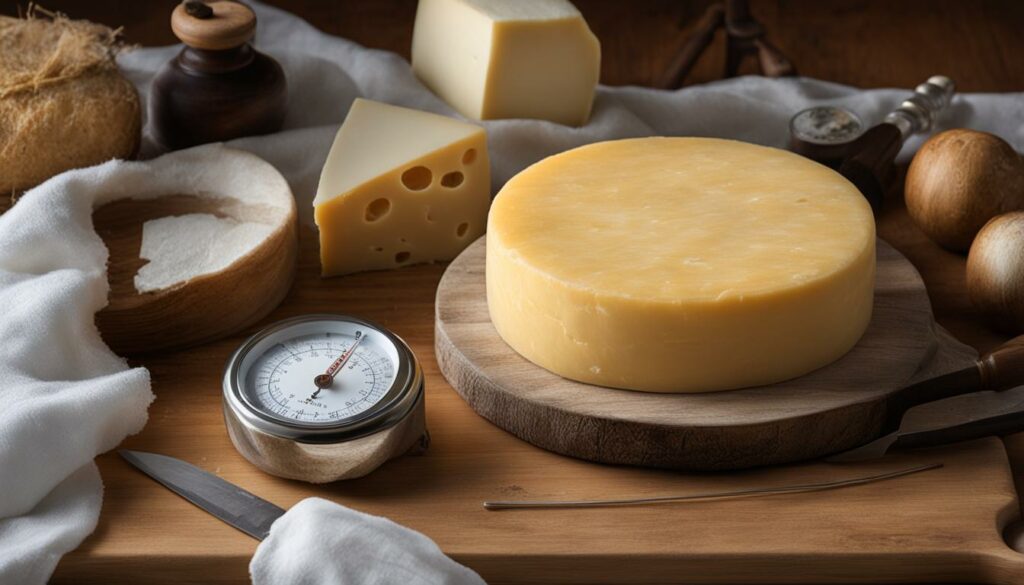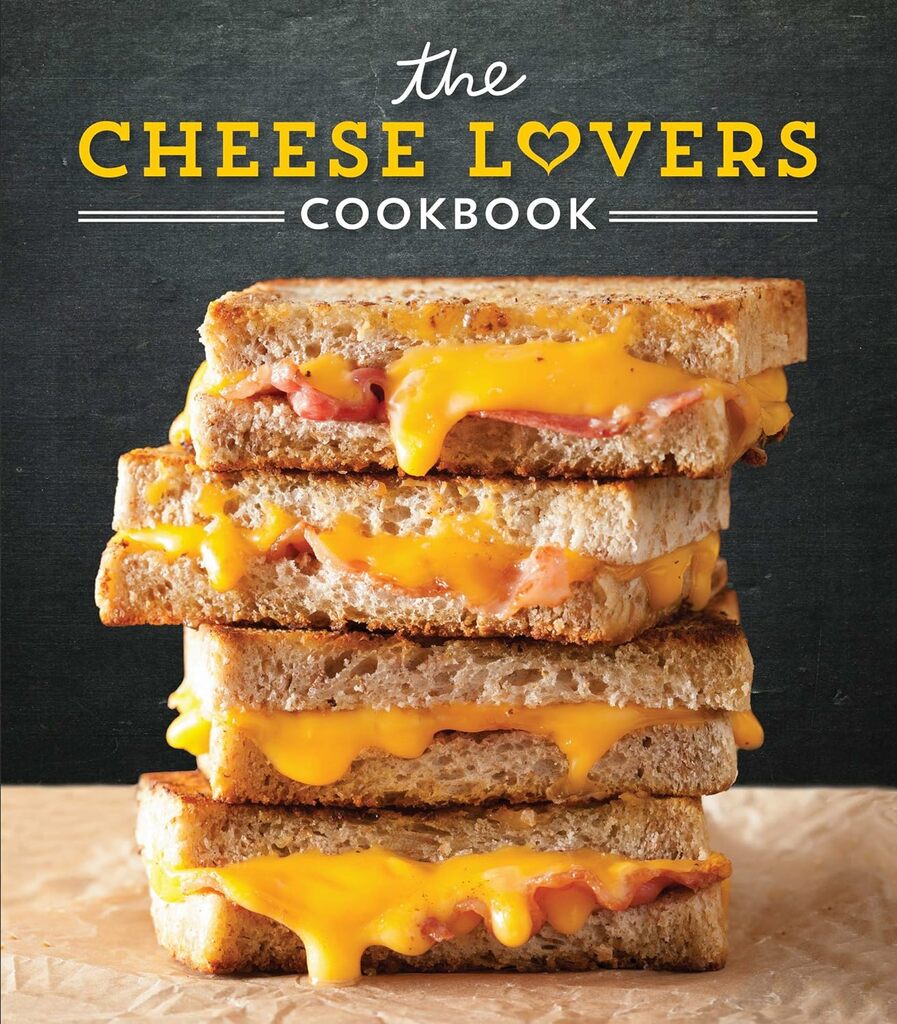Are you ready to embark on a culinary adventure that combines two of the most decadent delights? Imagine the rich, creamy flavors of cheese mingling with the smooth, velvety indulgence of chocolate. But here’s the question – what are the best pairings for cheese and chocolate?
Whether you’re a gourmet food enthusiast or a curious beginner, our comprehensive guide to cheese and chocolate pairings has got you covered. Discover the art of combining flavors, explore unique and delicious combinations, and learn how to balance the different profiles of cheese and chocolate.
From classic matches to innovative pairings, we’ll take you on a journey that will elevate your taste buds and leave you craving more. Get ready to savor the perfect cheese and chocolate union.
The Art of Combining Cheese and Chocolate
Combining cheese and chocolate is an art that requires a delicate balance of flavors. It involves understanding the unique characteristics of each ingredient and how they can work together to create a harmonious and indulgent pairing. Whether you’re a cheese connoisseur or a chocolate lover, exploring the world of cheese and chocolate pairings can be an exciting and rewarding experience.
Paring cheese and chocolate involves:
- Understanding texture: The texture of both cheese and chocolate plays a crucial role in their pairing. Creamy, smooth cheeses can complement the velvety richness of chocolate, while crumbly or aged cheeses can provide a delightful contrast.
- Exploring flavor profiles: Cheese and chocolate offer a wide range of flavors, from sweet and savory to tangy and bitter. Finding complementary or contrasting flavors can create a balanced and exciting taste experience.
- Balancing intensity: Some cheeses and chocolates have strong, bold flavors, while others are more subtle. Achieving balance between intense and delicate flavors is key to a successful pairing.
“The art of cheese and chocolate pairing lies in the understanding of how different textures and flavors can interact to create a truly memorable culinary experience.” – Cheese & Chocolate Enthusiast
By experimenting with different combinations and considering the balance of flavors, you can create your own unique pairings that showcase the best of both cheese and chocolate. Let your taste buds guide you as you explore the delectable world of cheese and chocolate pairings.
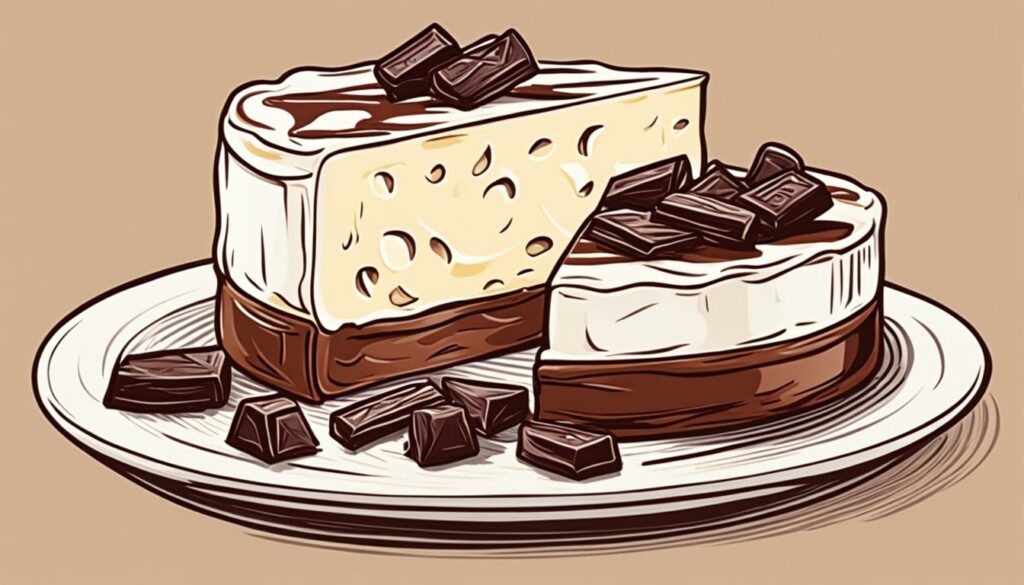
Savoring the Similarities: Fermentation in Cheese and Chocolate
Both cheese and chocolate undergo a fascinating fermentation process that contributes to their distinct flavors. Understanding this fermentation process is key to appreciating the complexities and nuances of both ingredients. In this section, we will explore the remarkable similarities between cheese and chocolate fermentation and delve into the role of microbes in flavor development.
Understanding the Fermentation Process
The fermentation process plays a crucial role in transforming the raw ingredients of cheese and chocolate into their delectable final products. In the case of cheese, fermentation occurs when benign bacteria consume lactose, the natural sugar found in milk, and convert it into lactic acid. This process gives cheese its signature tangy flavor and contributes to its unique texture.
Similarly, chocolate fermentation begins with the harvest of cacao pods. The cacao seeds, contained within the pods, undergo a microbial fermentation process. As the seeds are exposed to heat and humidity, naturally present yeasts and bacteria initiate fermentation. This microbial transformation breaks down the complex sugars within the seeds, leading to the development of chocolate’s rich flavor profiles.
The Role of Microbes in Flavor Development
Microbes play a vital role in the flavor development of both cheese and chocolate during fermentation. In cheese, specific strains of bacteria and fungi introduce enzymatic changes and metabolize lactose, proteins, and fats, contributing to the unique aromas and flavors. The diverse microbial community found in various cheese types leads to a wide range of tastes, from sharp and tangy to creamy and nutty.
In chocolate, the microbial activity during fermentation produces a multitude of volatile compounds that influence the aroma and flavor profiles. These compounds contribute to the desirable fruity, floral, and roasted notes found in different chocolate varieties. Additionally, the fermentation process is necessary for reducing the bitter and astringent flavors of raw cacao, making the resulting chocolate more palatable.
To visually appreciate the fermentation process in cheese and chocolate, take a moment to observe the image below:
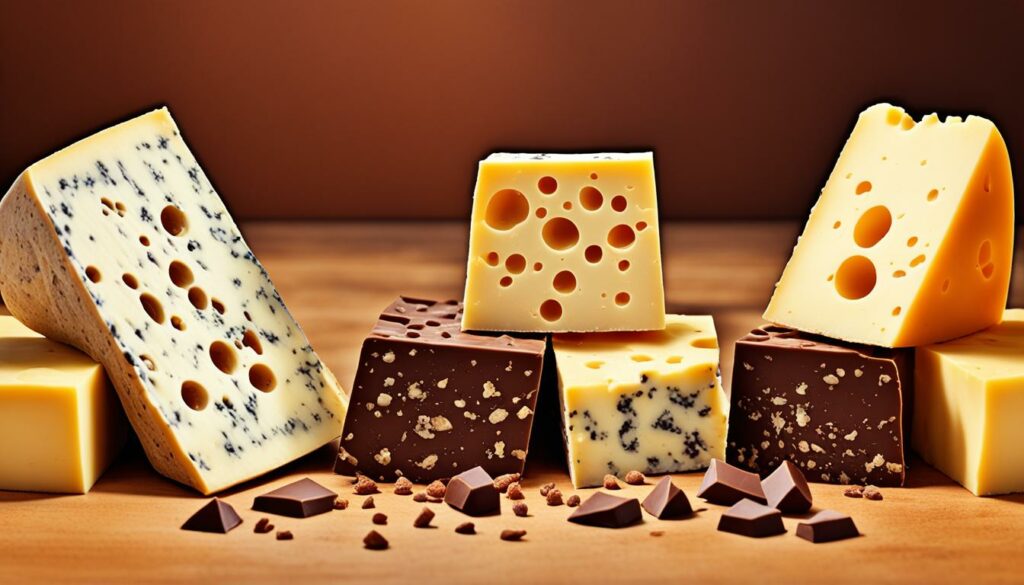
The image showcases the fascinating microbial processes that occur in both cheese and chocolate production, highlighting the critical role of fermentation in developing their distinct flavors.
Addictive Qualities of Cheese and Chocolate Explained
Cheese and chocolate have long been beloved indulgences, renowned for their addictive qualities. But what exactly is it about these delectable treats that keeps us coming back for more? In this section, we will delve into the chemistry behind our cravings for cheese and chocolate, uncovering the secrets that make them irresistible.
The Chemistry Behind Our Cravings
Our love for cheese and chocolate goes beyond mere taste. It turns out that there is a scientific basis for our cravings. Both cheese and chocolate contain compounds that stimulate feel-good neurotransmitters in our brains, such as dopamine. When we consume these delightful treats, dopamine is released, creating feelings of pleasure and satisfaction. This chemical reaction reinforces our desire to seek out cheese and chocolate, making them truly addictive.
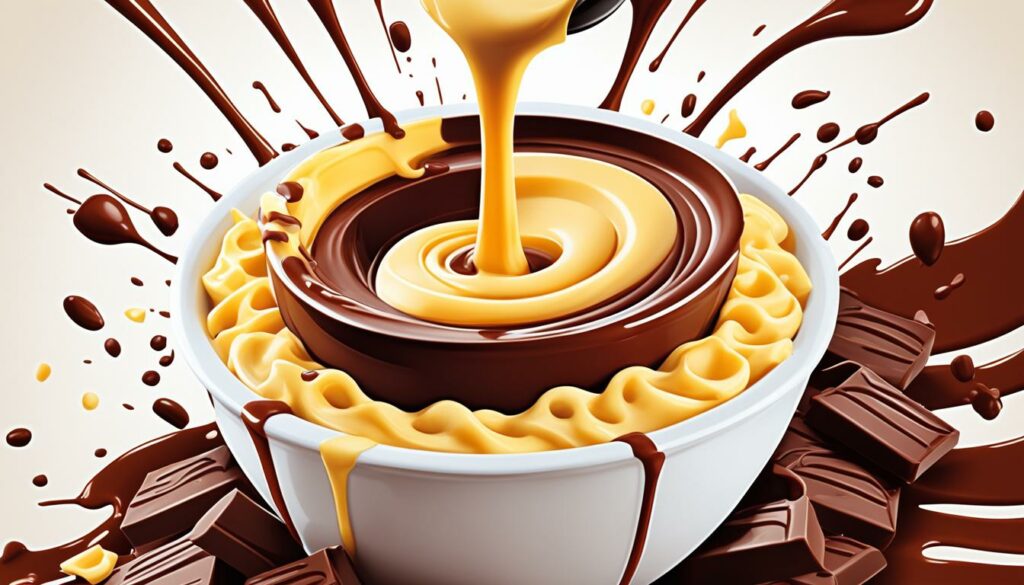
How Cheese Can Outshine Chocolate as a Mood Booster
While both cheese and chocolate have mood-boosting properties, cheese offers some unique advantages. The amino acid tryptophan, found in cheese, is a precursor to serotonin, a neurotransmitter that regulates mood and promotes feelings of well-being. Additionally, cheese contains high levels of protein and the fatty acid omega-3, which have been linked to improved mood and reduced symptoms of depression.
When it comes to enhancing your mood, cheese has the potential to outshine chocolate. So, if you’re looking for a pick-me-up, consider indulging in a savory cheese that not only satisfies your cravings but also provides a mood-boosting effect.
Next, we will explore essential pairing principles for cheese and chocolate combinations, ensuring that every bite is a harmonious and delightful experience.
Essential Pairing Principles for cheese ad chocolate pairings
When it comes to pairing cheese and chocolate, there are some essential principles to keep in mind. These principles will help you create harmonious combinations and ensure a delightful tasting experience. In this section, we will discuss the guidelines for pairing cheese and chocolate, including matching flavor profiles, considering acidity and sweetness, and finding pleasing contrasts. By understanding these essential principles, you will be able to create perfect pairings that showcase the best of both cheese and chocolate.
To create successful cheese and chocolate pairings, consider the following essential principles:
- Matching Flavor Profiles: Pair cheeses and chocolates that share similar flavor profiles. For example, a fruity and tangy goat cheese would pair well with a dark chocolate infused with berries.
- Considering Acidity and Sweetness: Balance acidity and sweetness between the cheese and chocolate to create a harmonious combination. A creamy and slightly sweet brie would pair nicely with a milk chocolate that has a balanced level of sweetness.
- Finding Pleasing Contrasts: Explore combinations that offer contrasting flavors and textures. For instance, a sharp and salty blue cheese can be paired with a rich and nutty dark chocolate to create an exciting taste experience.
By applying these essential pairing principles, you can elevate your cheese and chocolate pairings to new heights of deliciousness. Let your taste buds guide you as you experiment with different combinations and discover your personal favorites.
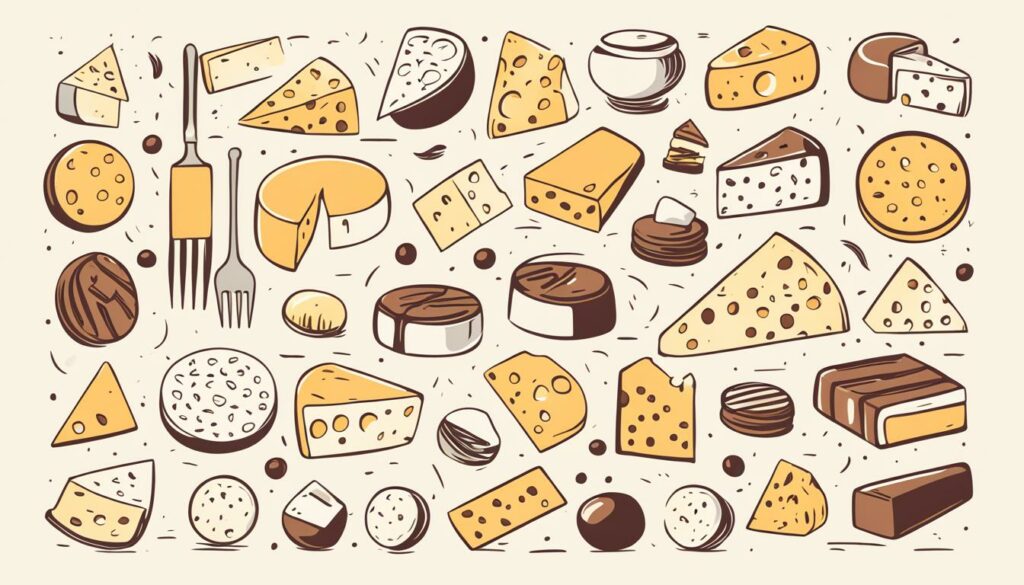
| Cheese | Chocolate |
|---|---|
| Brie | Milk Chocolate |
| Goat Cheese | Dark Chocolate with Berries |
| Gorgonzola | White Chocolate with Nuts |
| Cheddar | Sea Salt Chocolate |
“`
Please note that the table provided is a placeholder. Replace the current table with relevant and specific cheese and chocolate pairings that align with the essential pairing principles discussed in the text.
Starting with the Basics: Easy Cheese and Chocolate Matches
If you’re new to cheese and chocolate pairings, it’s best to start with easy matches that highlight the complementary flavors. In this section, we will provide a guide to cheese categories and chocolate types, helping you understand the characteristics of different cheeses and chocolates. We will also share some perfect pairings for beginners, featuring combinations that are sure to please your palate.
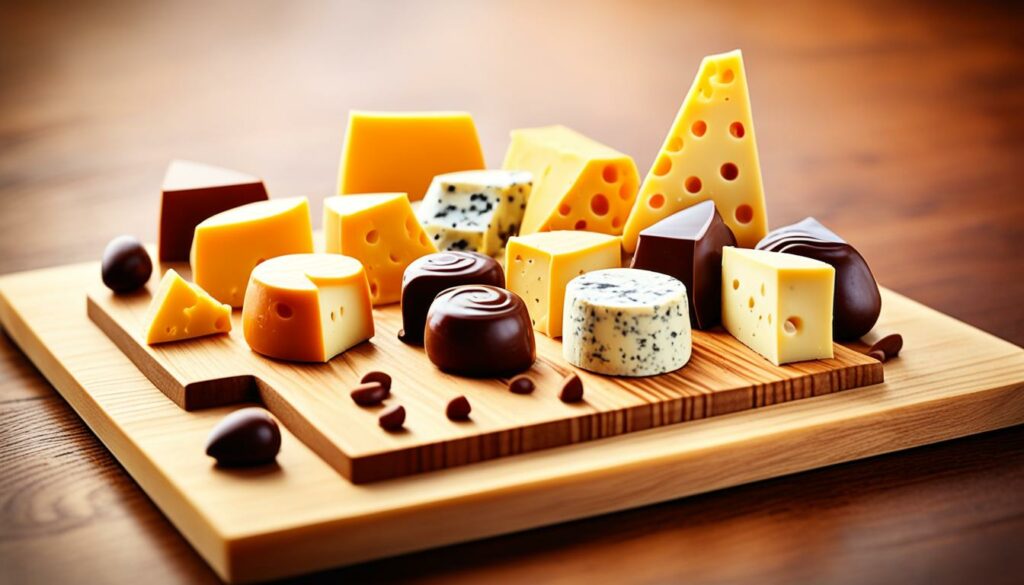
Guide to Cheese Categories and Chocolate Types
When exploring cheese and chocolate pairings, it’s important to familiarize yourself with the various cheese categories and chocolate types. Here’s a breakdown of some popular cheese categories and chocolate types:
| Cheese Categories | Chocolate Types |
|---|---|
| Fresh Cheese (e.g., mozzarella, ricotta) | Milk Chocolate |
| Semi-Soft Cheese (e.g., brie, camembert) | White Chocolate |
| Hard Cheese (e.g., cheddar, Parmesan) | Dark Chocolate |
| Blue Cheese (e.g., Roquefort, Gorgonzola) | Flavored Chocolate (e.g., chili, sea salt) |
By understanding the characteristics of different cheeses and chocolates, you can begin to identify potential pairings that complement each other’s flavors.
Perfect Pairings for Beginners
Now that you have an idea of the cheese categories and chocolate types, let’s explore some perfect pairings for beginners:
- Fresh Goat Cheese with Citrus-Infused White Chocolate
- Semi-Soft Brie with Raspberry Dark Chocolate
- Hard Gouda with Caramel Milk Chocolate
- Blue Stilton with Coffee Dark Chocolate
These pairings offer a balance of creamy, tangy, and sweet flavors that are easy to appreciate for those new to the world of cheese and chocolate.
Crafting the Perfect Palette: Gourmet Cheese and Chocolate Combinations
For those with more refined tastes, exploring gourmet cheese and chocolate combinations can take your pairings to the next level. Elevate your tasting experience with carefully curated combinations that highlight the complex flavors and textures of these indulgent treats.
Pairings for the Connoisseur
As a connoisseur, you appreciate the intricacies of flavor and seek out the finest culinary experiences. Pairing gourmet cheeses with high-quality chocolates will delight your discerning palate. Think aged artisanal cheeses with rich, dark chocolates or tangy blue cheeses with silky-smooth milk chocolates. These expertly crafted pairings will take your cheese and chocolate tasting to new heights.
Unique Pairings for an Elevated Tasting Experience
If you’re looking to push the boundaries and experiment with bold and unique combinations, there are endless possibilities to explore. Try pairing a sharp Parmigiano-Reggiano with a salted caramel chocolate for a delightful balance of savory and sweet. Or indulge in a creamy Brie with a fruity and spicy dark chocolate for an unexpected yet satisfying contrast. These unique pairings offer an elevated tasting experience that will impress even the most adventurous food enthusiasts.
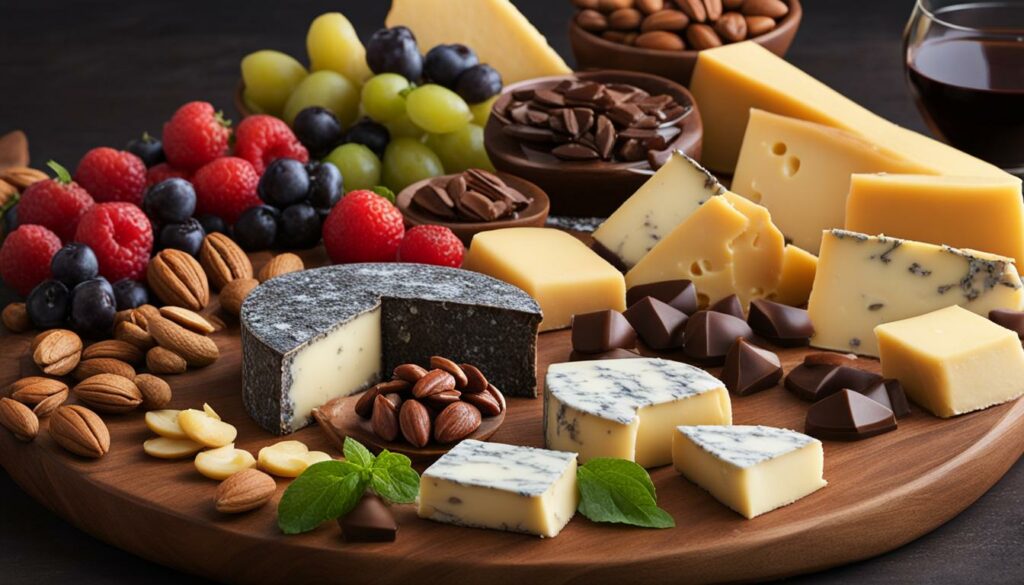
Continue your cheese and chocolate pairing journey by exploring these gourmet combinations. Let your taste buds revel in the harmonious flavors and luxurious textures that only the confluence of cheese and chocolate can deliver.
Pairing by Profiles: Similar Flavors and Pleasing Contrasts
Pairing cheese and chocolate can be a delightful adventure of discovering the perfect combination of flavors. By considering the profiles of both cheese and chocolate, you can create pairings that complement each other or create exciting contrasts on your taste buds. Let’s explore the art of pairing by profiles, discovering the similarities in flavors that harmonize beautifully and the contrasts that create a thrilling sensory experience.
Similar flavors in cheese and chocolate can create a harmonious pairing that showcases their shared qualities. For example, the nutty undertones in a slightly aged Gouda can be accentuated by the richness of dark chocolate, enhancing the overall experience. Alternatively, pairing a tangy blue cheese with a bittersweet chocolate can create a unique flavor combination that highlights their bold characteristics.
On the other hand, seeking pleasing contrasts between cheese and chocolate can create an exciting taste experience. The creamy texture of a Camembert can be complemented by the bitterness of a dark chocolate with hints of citrus or coffee. This contrast brings out the best of both ingredients, creating a memorable sensory journey on your palate.
When pairing by profiles, you have the freedom to explore a wide range of flavors and textures. Whether you prefer the harmonious combination of nutty flavors or the thrilling contrast between creamy and bitter, the world of cheese and chocolate pairings offers endless possibilities for delightful taste experiences.
Acidity and Sweetness: Balancing Cheese and Chocolate
When it comes to pairing cheese and chocolate, achieving the perfect balance of acidity and sweetness is essential. This balance enhances the flavors of both ingredients and creates harmonious combinations that tantalize the taste buds. Understanding the acidity in cheese and chocolate, as well as the sweetness they bring, is key to unlocking a truly delightful pairing experience.
Both cheese and chocolate exhibit varying levels of acidity. Some cheeses, such as goat cheese and blue cheese, have a tangy and slightly acidic taste, while others are more mellow and less acidic. Similarly, different types of chocolate can vary in acidity, with dark chocolate generally being more acidic than milk chocolate.
It is important to consider the acidity levels of both cheese and chocolate when pairing them. Balancing a tangy cheese with a slightly sweeter chocolate can help to offset the acidity and create a more well-rounded flavor profile.
The sweetness in cheese and chocolate can also play a crucial role in finding the perfect balance. Some cheeses naturally have a sweeter flavor, such as Gouda or Brie, while others may be more savory or even salty. Chocolate, on the other hand, can range from bittersweet to milky and sweet.
By understanding the sweetness in cheese and chocolate, you can create pairings that complement and enhance each other. Pairing a sweet, creamy cheese with a rich, dark chocolate can create a delightful contrast of flavors, while combining a savory cheese with a sweeter, milk chocolate can create a harmonious blend of tastes.
Experimenting with different combinations of acidity and sweetness in cheese and chocolate pairings allows you to explore the full range of flavors and discover unique and delicious combinations.
| Cheese | Acidity Level | Sweetness Level |
|---|---|---|
| Goat Cheese | High | Medium |
| Blue Cheese | High | Low |
| Gouda | Low | High |
| Brie | Low | High |
| Chocolate | Acidity Level | Sweetness Level |
|---|---|---|
| Dark Chocolate | High | Low |
| Milk Chocolate | Low | High |
| White Chocolate | Low | Very High |
By referring to the acidity and sweetness levels of different cheeses and chocolates, you can make informed decisions when creating your own cheese and chocolate pairings. Consider these factors as you explore the vast world of flavors and find the perfect balance for a truly delightful pairing experience.
Decadent and Delicious: Cheese and Chocolate Tasting Ideas
When it comes to hosting a cheese and chocolate tasting party, the possibilities are endless. This decadent and delicious experience is sure to impress your guests and provide a unique culinary adventure. Whether you’re a seasoned food enthusiast or just looking to explore new flavors, we have some creative cheese and chocolate tasting ideas that will inspire your own gathering.
Creating Your Own Cheese and Chocolate Tasting Party:
- Start by selecting a variety of cheeses and chocolates. Aim for a diverse range of flavors, textures, and intensities to provide your guests with a well-rounded tasting experience.
- Consider pairing different types of cheeses with complementary chocolates. For example, a creamy brie can be paired with a smooth milk chocolate, while a sharp cheddar can be paired with a dark chocolate with hints of fruit.
- Arrange the cheeses and chocolates on a platter or cheese board, ensuring they are visually appealing and easy to navigate. A well-organized display adds to the overall experience.
- Provide tasting notes or cards for each cheese and chocolate so that guests can take notes and compare their favorites.
- Encourage your guests to experiment with different combinations. Let them explore their preferences and discover unique flavor profiles.
- Have some palate cleansers available, such as plain crackers or pieces of fruit, to refresh the taste buds between tastings.
Tips for Serving and Presentation
Presenting your cheese and chocolate tasting in an appealing way is key to creating a memorable experience. Consider the following tips for serving and presentation:
- Use a variety of serving dishes to add visual interest to your presentation. Mixing textures and colors can make the spread more inviting.
- Label each cheese and chocolate with individual tags to help guests identify the flavors and origins.
- Pair different types and shapes of cheeses and chocolates to create an aesthetically pleasing arrangement on your serving platter.
- Consider incorporating some decorative elements, such as fresh herbs or edible flowers, to add a touch of elegance.
- Ensure that you have enough serving utensils for guests to use when sampling the cheeses and chocolates.
By following these tips and getting creative with your cheese and chocolate tasting ideas, you’ll be able to create an unforgettable experience for your guests. Now, let’s take a look at an example of how you can set up your own cheese and chocolate tasting party:
| Cheese | Chocolate |
|---|---|
| Brie | Milk Chocolate |
| Goat Cheese | White Chocolate with Raspberry |
| Gorgonzola | Dark Chocolate with Sea Salt |
| Cheddar | Dark Chocolate with Chili |
In this example, you have a selection of four different cheeses paired with complementary chocolates. Arrange them on a serving platter, with each cheese placed next to its corresponding chocolate. Provide tasting notes and palate cleansers, and let your guests explore the delicious combinations.
Remember, the key to a successful cheese and chocolate tasting party is to get creative and have fun. Experiment with different flavor profiles, textures, and presentations to create a truly decadent and delightful experience for everyone. Your guests will be in awe of your cheese and chocolate extravaganza!
Why Cheese and Chocolate Are the New Dynamic Duo
Cheese and chocolate, two indulgent treats that have long been enjoyed separately, have now emerged as a new dynamic duo in the culinary world. These beloved ingredients complement each other in stunning ways, creating a harmonious symphony of flavors that is sure to delight any food enthusiast. In this section, we will explore the journey of cheese and chocolate from ancient traditions to modern tastings, uncovering the cultural significance of pairing these two delights throughout history.
From Ancient Traditions to Modern Tastings
The pairing of cheese and chocolate is not a recent phenomenon. In fact, ancient civilizations such as the Mayans and Aztecs revered both cheese and chocolate for their rich flavors and believed in their spiritual and medicinal properties. The Mayans even had their own version of a cheese and chocolate beverage, combining the two ingredients with spices to create a luxurious elixir. Over the centuries, as cheese-making and chocolate production techniques evolved, so did the appreciation for pairing these two extraordinary delicacies.
“The harmony between cheese and chocolate represents a culmination of centuries of gastronomic exploration, bringing together the best of two beloved culinary traditions.”
Today, cheese and chocolate pairings have undergone a renaissance. Cheesemakers and chocolatiers are pushing the boundaries of creativity, experimenting with unique and unexpected combinations that surprise and delight the palate. From artisanal small-batch productions to large-scale industries, the possibilities of cheese and chocolate pairings are seemingly endless.
Health Benefits of Cheese and Chocolate Pairings
It’s not just the incredible flavors that make cheese and chocolate pairings a match made in heaven. There are also notable health benefits associated with consuming these delectable combinations. Both cheese and chocolate contain beneficial compounds that can positively impact our well-being.
Cheese is a rich source of essential nutrients such as calcium, protein, and vitamins. The consumption of cheese has been linked to improved bone health, muscle function, and cardiovascular health. When paired with chocolate, the combination can provide a balanced blend of nutrients that contribute to overall well-being.
Similarly, chocolate is known for its antioxidant properties and its ability to boost mood and improve cognitive function. When enjoyed with cheese, the combination can elevate these benefits, creating a truly indulgent and healthful experience.
To fully appreciate the health benefits of cheese and chocolate pairings, it’s important to choose high-quality ingredients that are minimally processed and made with care. Opt for artisanal cheeses and chocolates that are crafted with attention to detail and craftsmanship.
| Cheese | Chocolate |
|---|---|
| Gouda | Milk Chocolate |
| Blue Cheese | Dark Chocolate |
| Goat Cheese | White Chocolate |
| Brie | Sea Salt Caramel Chocolate |
| Cheddar | Almond Chocolate |
Table: Delicious Cheese and Chocolate Pairings
The table above highlights some delicious pairings to guide you on your cheese and chocolate tasting journey. These combinations showcase the incredible diversity of flavors that can be achieved when these two ingredients come together.
Conclusion
In conclusion, the world of cheese and chocolate pairings offers a delightful journey for food enthusiasts. By understanding the art of combining flavors and following the essential principles of pairing, you can explore a wide range of delectable combinations. Whether you prefer the classic pairings or are adventurous enough to try unique combinations, the possibilities are endless.
We hope this comprehensive guide has inspired you to embark on your own cheese and chocolate tasting adventure. Discover the perfect pairings that bring together the richness of cheese and the indulgence of chocolate, tantalizing your taste buds with each bite. Remember, the key to a successful pairing is finding the right balance of flavors and textures.
So go ahead, indulge in the indulgence and enjoy the wonderful world of cheese and chocolate pairings. Experiment with different cheeses and chocolates, explore new flavor combinations, and let your palate be your guide. Whether you’re hosting a cheese and chocolate tasting party or simply enjoying a quiet evening at home, embrace the joy of this dynamic duo and savor every moment. Happy pairing!
FAQ
What are some essential principles for cheese and chocolate pairings?
When pairing cheese and chocolate, it’s important to match flavor profiles, consider acidity and sweetness, and find pleasing contrasts.
Where should beginners start with cheese and chocolate pairings?
Beginners can start with easy matches that highlight complementary flavors. Understanding cheese categories and chocolate types can help in finding perfect pairings.
Are there gourmet cheese and chocolate combinations for connoisseurs?
Yes, pairings for connoisseurs include aged artisanal cheeses and handcrafted chocolates that highlight complex flavors and textures.
How can I create harmonious combinations when pairing by flavor profiles?
Pairing similar flavors can create a harmonious taste experience, while seeking contrasts can provide an exciting sensory journey.
What is the importance of balancing acidity and sweetness when pairing cheese and chocolate?
Balancing acidity and sweetness is crucial for creating harmonious combinations and enhancing the flavors of both cheese and chocolate.
How can I host a cheese and chocolate tasting party?
You can create a memorable tasting experience by selecting the perfect cheeses and chocolates, arranging them for serving, and creating a visually appealing presentation.
What is the history of cheese and chocolate pairings?
Cheese and chocolate have a long history, and pairing them has significance in ancient traditions. Their recent resurgence offers an indulgent combination to explore.
Are there health benefits associated with cheese and chocolate pairings?
Yes, cheese and chocolate pairings are believed to have mood-boosting properties and contain beneficial compounds.

